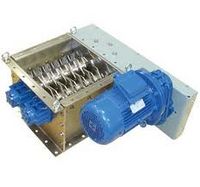Difference between revisions of "Lump Breakers"
(Created page with "Category:Particle Size Reduction{{Knoppen}} <noinclude><!------------------------------------------------ * READ THIS FIRST * Only edit this page if you can improve the ...") |
|||
| (One intermediate revision by one other user not shown) | |||
| Line 1: | Line 1: | ||
[[Category:Particle Size Reduction]]{{Knoppen}} | [[Category:Particle Size Reduction]]{{Knoppen}} | ||
[[File:Lump Breakers_1.jpg|thumb|200px|right|Lump Breakers]] | |||
'''Lump Breakers''', also referred to as [[Delumping Mills]], are used to break down lumps and aggregates in bulk solids and powders. | |||
==Common Types== | |||
===Low Speed Lump Breakers=== | |||
Low Speed versions are for gentle crushing duties on brittle products that require breaking down without the generation of excessive dust and fines. Heat or work sensitive granules, such as resins, are fractured and reduced to smaller pieces by a powerful low-speed crushing, without the violent shattering and disintegration that accompanies the more dynamic action of high impact speeds. A higher proportion of granules are created in the upper size range determined by the grill, and less fines | |||
The shafts and blades impose a three-stage action on the lumps, wedging and crushing against the casing and grill by means of the square shaft and the short radius edges of the mechanism. The residual lumps are forced through the grill by means of the sliding and crushing action of the blade edges. | |||
===High Speed Lump Breakers=== | |||
High Speed breakers are more destructive of the granular materials, combining the effect of impact, wedging and trapping at a rapid rate, to fracture the chunks into a wide range of particulate fractions, none larger than will pass through the grid. | |||
==Design== | |||
A distinctive feature of the design is that the blade fixings are radially offset to the square centre shaft in order to develop progressive sliding contact forces and provide a strong mechanical fixture of the blades by virtue of utilising the shear strength, rather than tensile strength of the connection. This robust construction reflects the exploitation of mechanical and solids rheological principles that give the machines a competitive edge over conventional design. | |||
==Video== | |||
<youtube>59TmgQayifw</youtube> | |||
Latest revision as of 05:46, 18 February 2013
Lump Breakers, also referred to as Delumping Mills, are used to break down lumps and aggregates in bulk solids and powders.
Common Types
Low Speed Lump Breakers
Low Speed versions are for gentle crushing duties on brittle products that require breaking down without the generation of excessive dust and fines. Heat or work sensitive granules, such as resins, are fractured and reduced to smaller pieces by a powerful low-speed crushing, without the violent shattering and disintegration that accompanies the more dynamic action of high impact speeds. A higher proportion of granules are created in the upper size range determined by the grill, and less fines
The shafts and blades impose a three-stage action on the lumps, wedging and crushing against the casing and grill by means of the square shaft and the short radius edges of the mechanism. The residual lumps are forced through the grill by means of the sliding and crushing action of the blade edges.
High Speed Lump Breakers
High Speed breakers are more destructive of the granular materials, combining the effect of impact, wedging and trapping at a rapid rate, to fracture the chunks into a wide range of particulate fractions, none larger than will pass through the grid.
Design
A distinctive feature of the design is that the blade fixings are radially offset to the square centre shaft in order to develop progressive sliding contact forces and provide a strong mechanical fixture of the blades by virtue of utilising the shear strength, rather than tensile strength of the connection. This robust construction reflects the exploitation of mechanical and solids rheological principles that give the machines a competitive edge over conventional design.
Video
